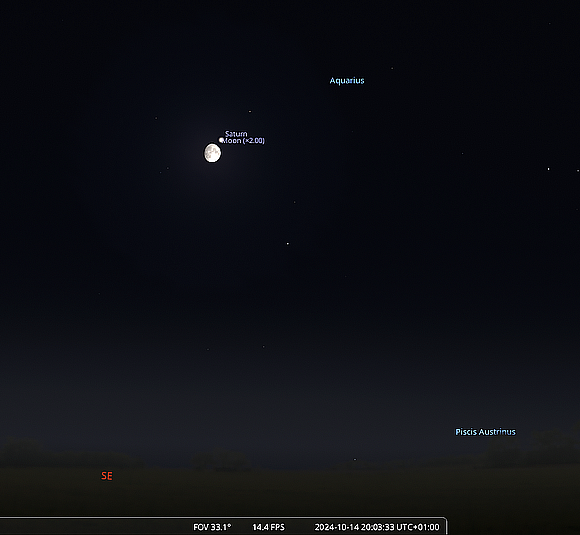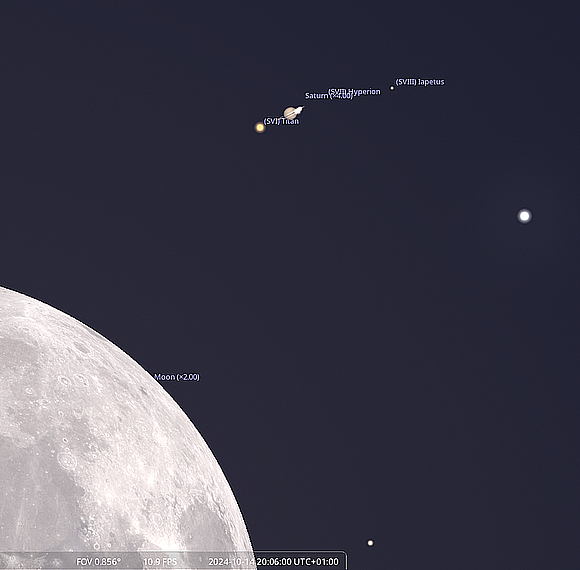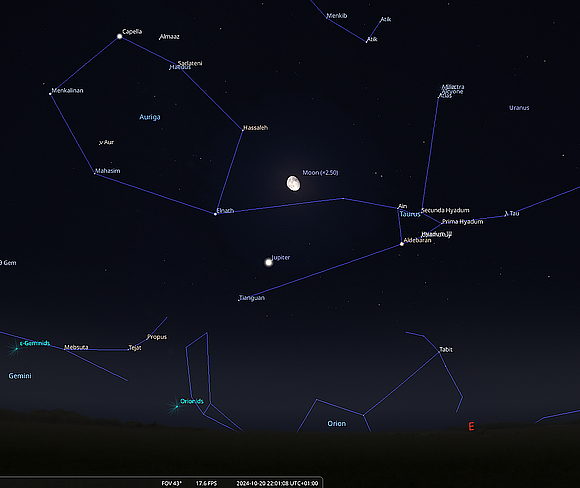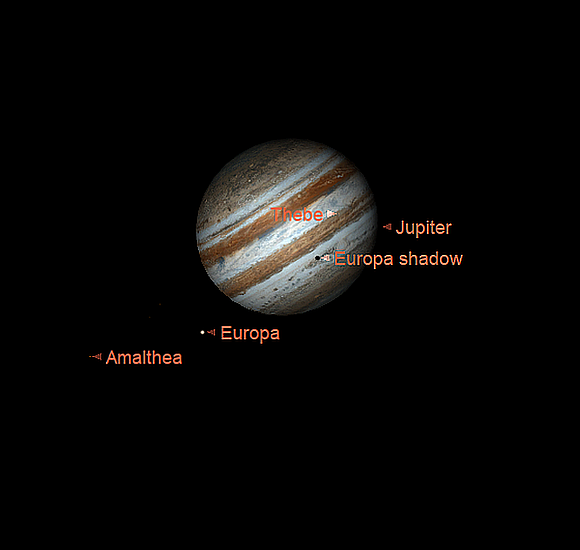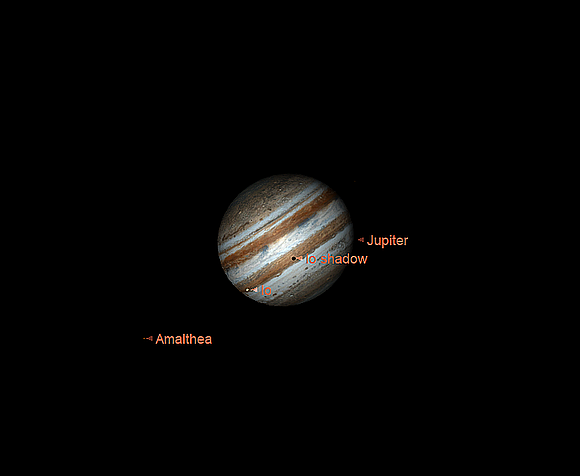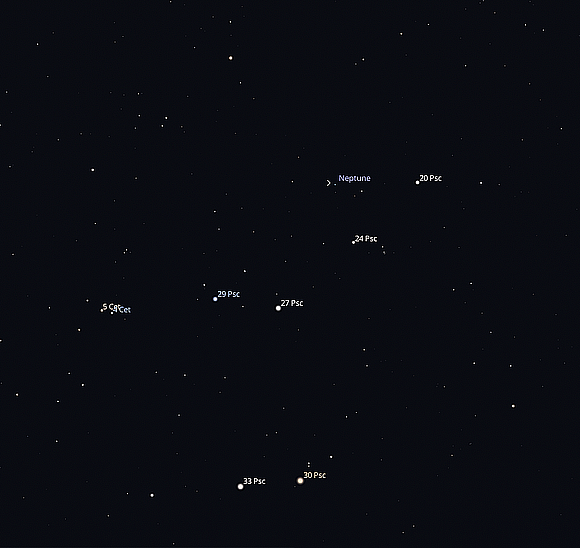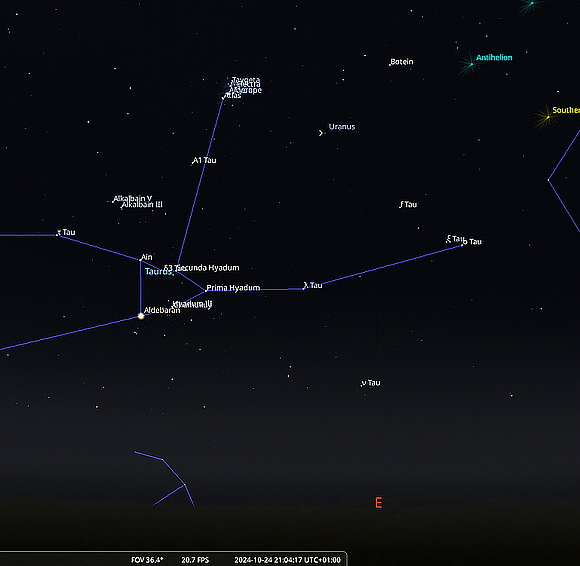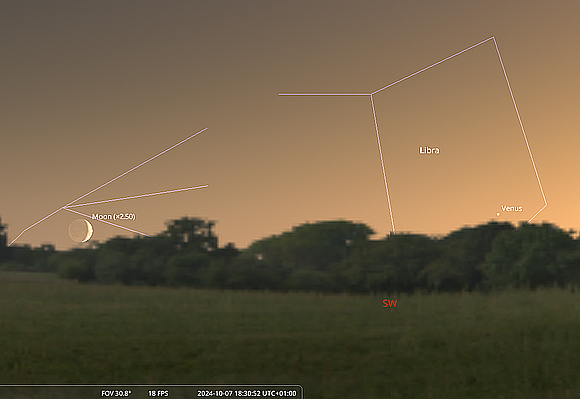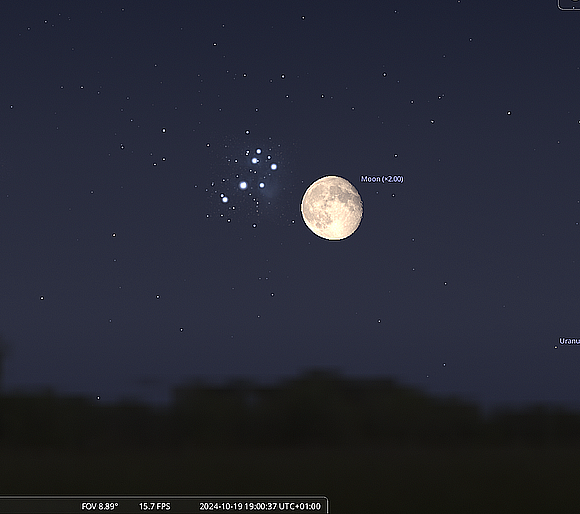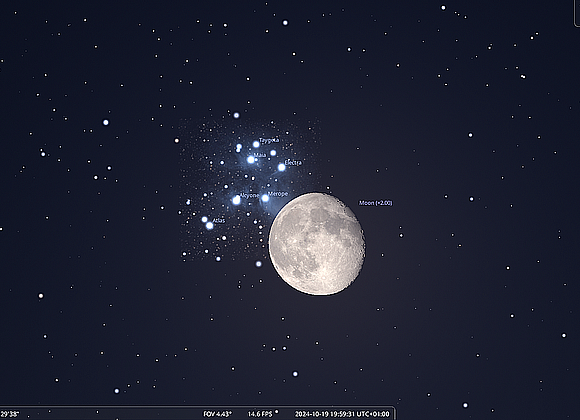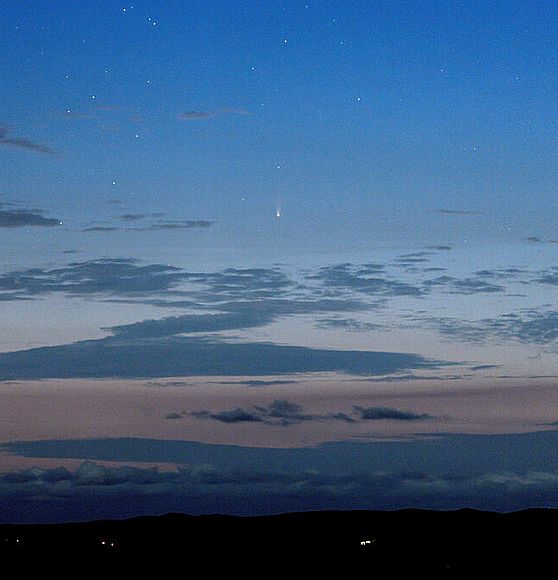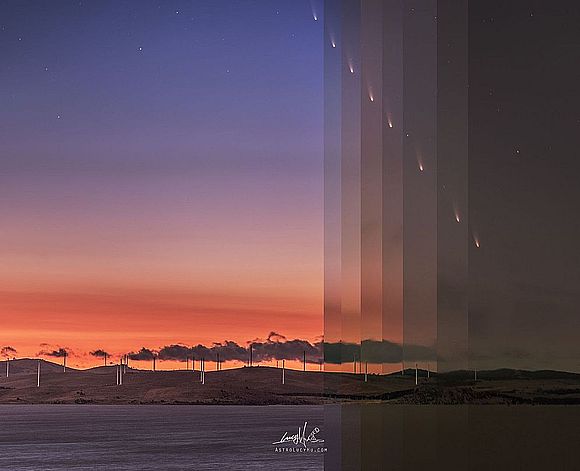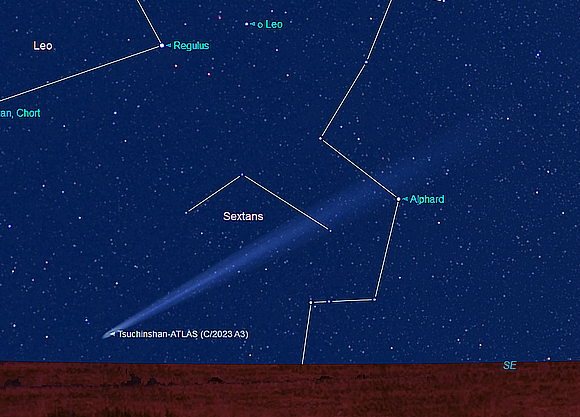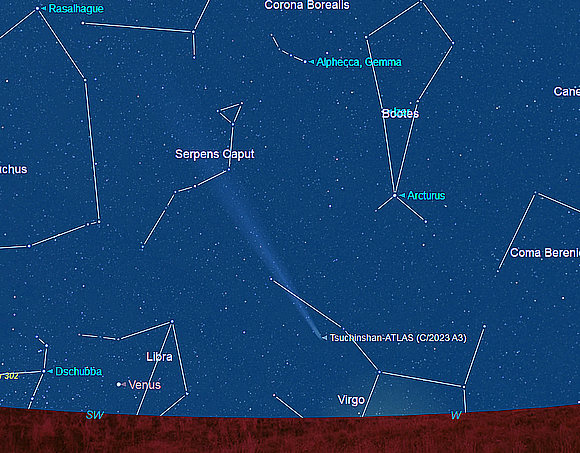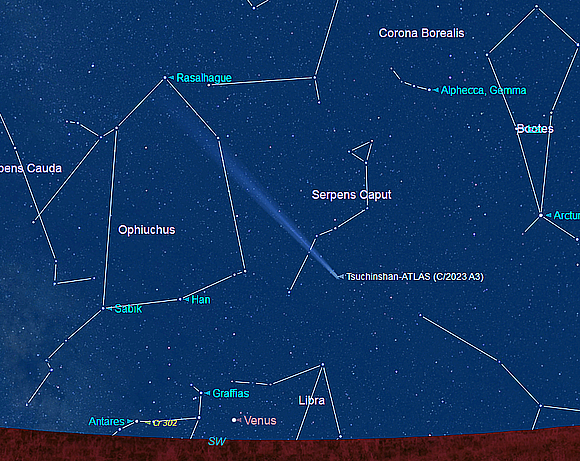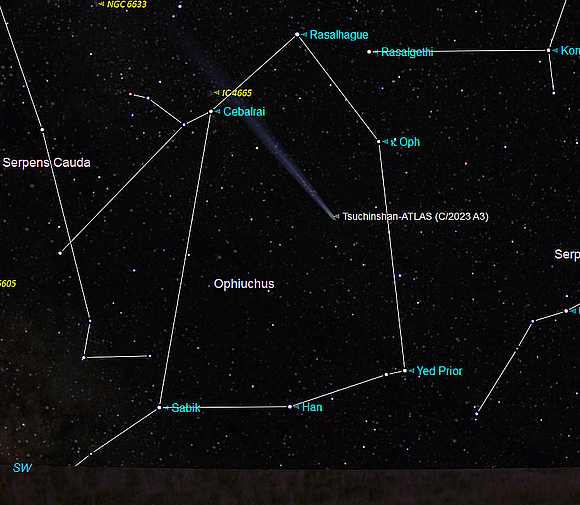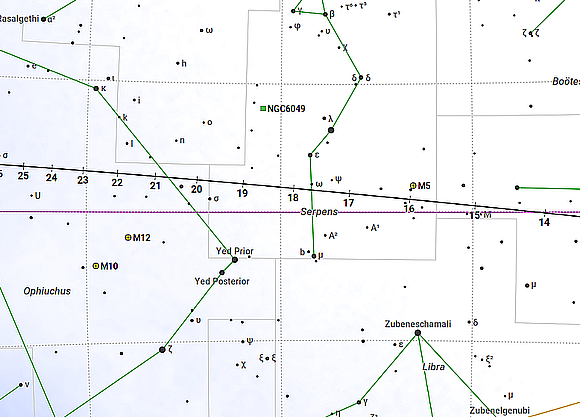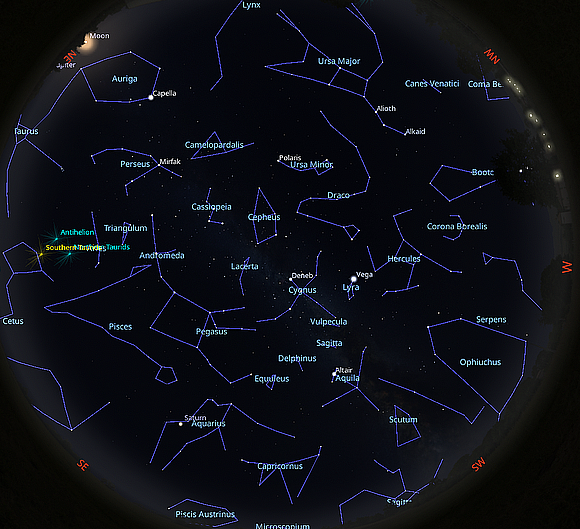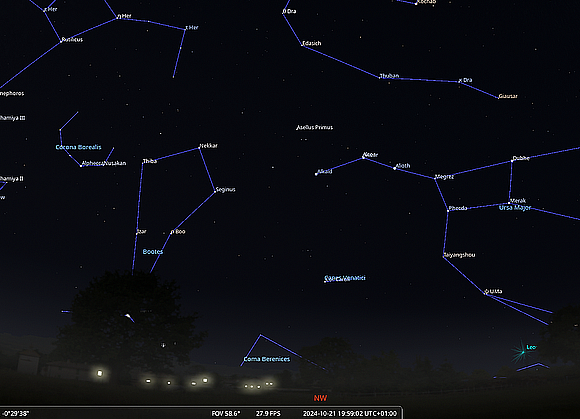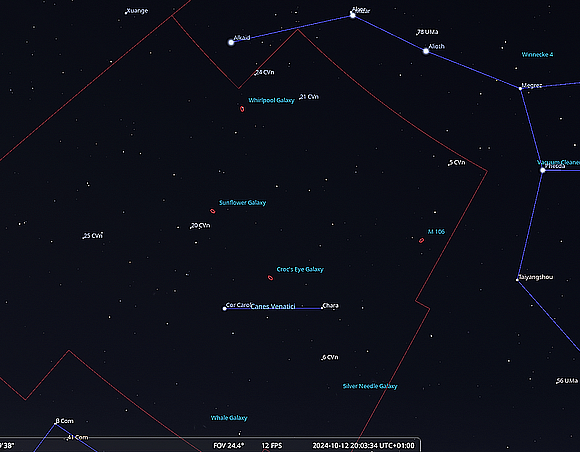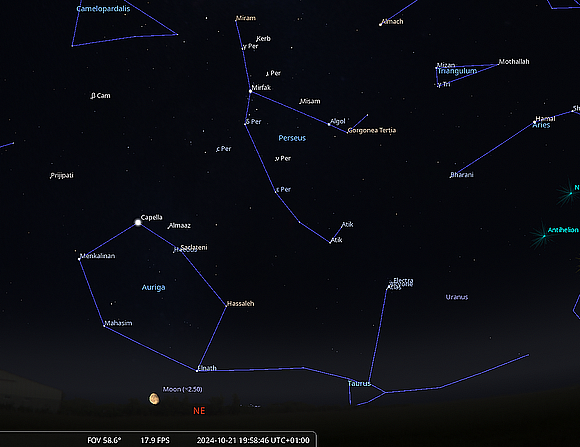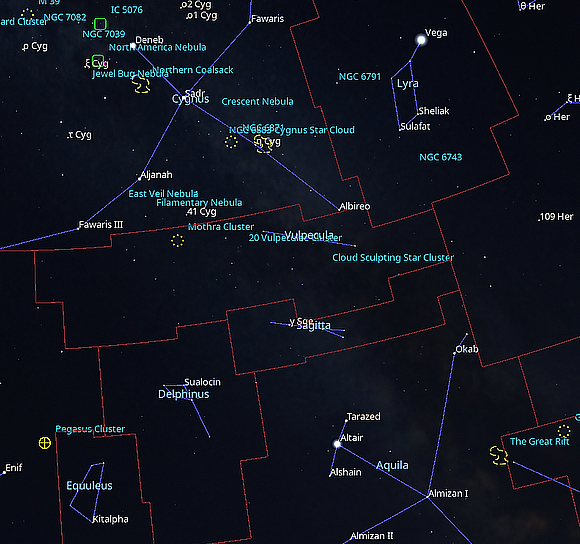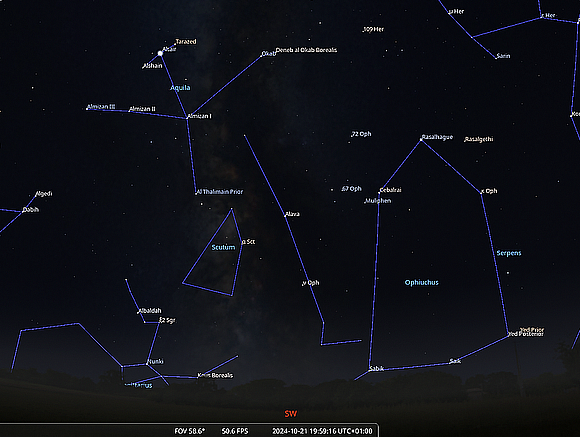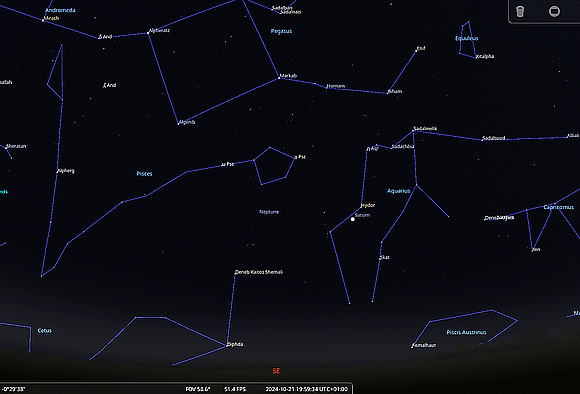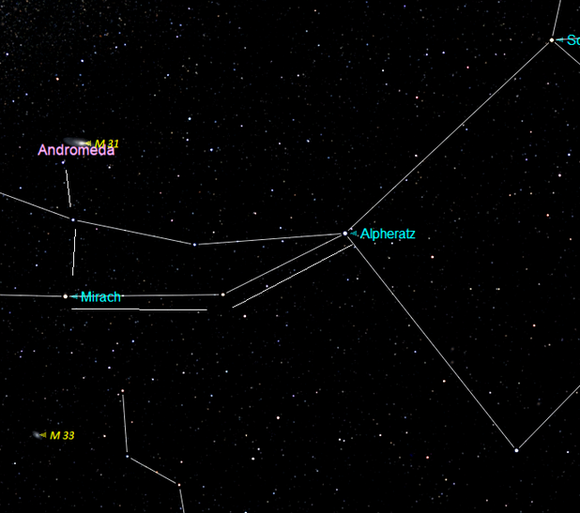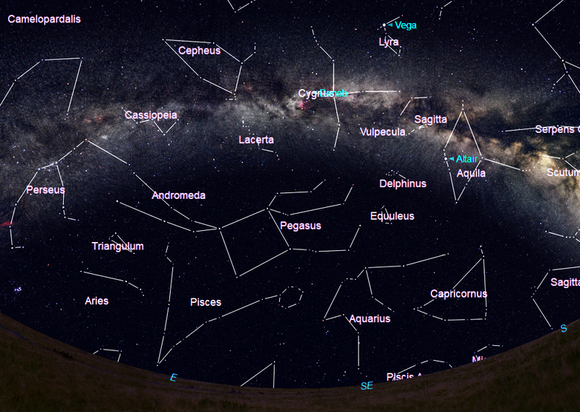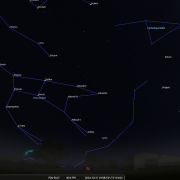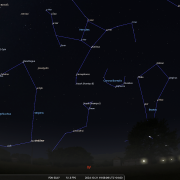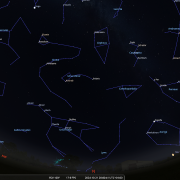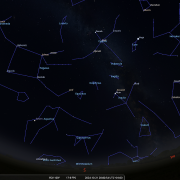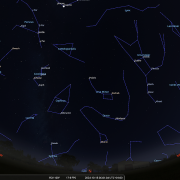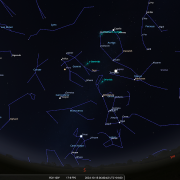cIn this month's Sky Notes:
- Planetary Skylights
- Comet C/2023 A3
- October Meteors and Aurora sightings
- October Night Sky
- October 2024 Sky Charts
Planetary Skylights: A Brief Guide to October's Night Sky
Saturn is now well placed in the late evening sky. Jupiter is very conspicuous low to the east, with Mars also visible low to the ENE. Uranus and Neptune require telescopic augmentation to track down in the evening/night sky.
 Saturn is already above the horizon as darkness falls at the beginning of October, favourably placed in the SE by 21:00hrs. By the time clocks go back in the UK on October 27th Saturn will be crossing the meridian - due south by 20:00hrs, ideally placed for observation. Residing amongst the faint star of Aquarius, at magnitude +0.7 Saturn will stand out in a region of the sky devoid of brighter stars. Culminating a respectable 23 degrees above the horizon, Saturn is nevertheless still 7degrees below the celestial equator from the UK. The good news is that Saturn will continue to gain in declination over the coming years, crossing into the northern half of the sky by 2026.
Saturn is already above the horizon as darkness falls at the beginning of October, favourably placed in the SE by 21:00hrs. By the time clocks go back in the UK on October 27th Saturn will be crossing the meridian - due south by 20:00hrs, ideally placed for observation. Residing amongst the faint star of Aquarius, at magnitude +0.7 Saturn will stand out in a region of the sky devoid of brighter stars. Culminating a respectable 23 degrees above the horizon, Saturn is nevertheless still 7degrees below the celestial equator from the UK. The good news is that Saturn will continue to gain in declination over the coming years, crossing into the northern half of the sky by 2026.
Through the eyepiece Saturn can be a splendid sight, but right now the rings are less than 5 degrees in orientation and closing, the appearance unfamiliar to anyone who has not been keeping close tabs on Saturn. Ring plane crossing occurs in March 2025. You can spot Saturn's largest moon, Titan, in nearly all apertures, visible as a speck of light nearby, but another 7 moons are visible to 'amateur telescopes' especially when the rings are closed. Rhea, Tethys, Dione and Iapetus are more likely to be glimpsed in instruments above 200mm (8"). On October 14th a waxing Quarter Moon resides just below Saturn in a fine, close conjunction.
 Mighty Jupiter’s presence in the late evening sky grows ever more conspicuous, visible around 21:30hrs BST at the start of October and by 18:30hrs GMT at the end. Residing in the heart of Taurus the Bull, Jupiter appears to hardly move in relation to the background stars near the 'horns' of the Bull over the course of October. In fact, Jupiter has reached a stationary point (seeming to stop in the sky) and it's only at the very end of October it slowly begins retrograde motion (westwards movement) back toward Aldebaran the 'ruddy eye’ and chief star of Taurus. At magnitude -2.4 Jupiter is already very conspicuous but is still 2 months from opposition reaching mag -2.55 by the months end.
Mighty Jupiter’s presence in the late evening sky grows ever more conspicuous, visible around 21:30hrs BST at the start of October and by 18:30hrs GMT at the end. Residing in the heart of Taurus the Bull, Jupiter appears to hardly move in relation to the background stars near the 'horns' of the Bull over the course of October. In fact, Jupiter has reached a stationary point (seeming to stop in the sky) and it's only at the very end of October it slowly begins retrograde motion (westwards movement) back toward Aldebaran the 'ruddy eye’ and chief star of Taurus. At magnitude -2.4 Jupiter is already very conspicuous but is still 2 months from opposition reaching mag -2.55 by the months end.
Through the eyepiece Jupiter’s oblate globe is a whopping 47 arc seconds in diameter, making for pleasing observations - even with modest instruments. The darker cloud belts should be obvious, but when turned in our direction look for the great red spot feature, which must be said appears far paler and smaller than 30 years ago. The GRS can be observed in 75-100mm (3”- 4”) scopes but will be more obvious in 150mm (6”) instruments at medium powers. Look for the GRS on the 2nd, 7th, 9th, 14th, 19th, 21st and 26th from 21:30hrs to 22:30hrs BST.
One aspect of the Jovian system noticeable using even humble binoculars are the attendant Galilean moons, the dance of these four large bodies over successive nights is fascinating to follow. Seen as specks of light the configuration and number of the Galilean moons constantly evolve as they orbit around Jupiter. As the opposition of Jupiter approaches, shadow transits of the moons will become more numerous, but for this month more favourable events are - Europa - Oct 13th at 22:30hrs BST, and Io Oct 18th at 22:00hrs BST. Overnight of Oct 20th look for a waning gibbous Moon below Jupiter.
 Mars rises shortly after 23:00hrs BST as October commences and by 21:00hrs GMT at the end of the month. The Red Planet starts the month in the heart of Gemini, ending it in perfect alignment below the Twins leading stars, Castor and Pollux. Jupiter lies over 28 degrees upper right. Over the course of October Mars brightens considerably from magnitude +0.5 to +0.1, substantially brighter than the nearby 'twins' and the red supergiant star Betelgeuse in Orion. Residing in Gemini Mars attains a very healthy altitude, more than 60 degrees by the end of the night, well clear of any bad seeing lower down, offering over 5 hours of observation time above the 30-degree elevation level.
Mars rises shortly after 23:00hrs BST as October commences and by 21:00hrs GMT at the end of the month. The Red Planet starts the month in the heart of Gemini, ending it in perfect alignment below the Twins leading stars, Castor and Pollux. Jupiter lies over 28 degrees upper right. Over the course of October Mars brightens considerably from magnitude +0.5 to +0.1, substantially brighter than the nearby 'twins' and the red supergiant star Betelgeuse in Orion. Residing in Gemini Mars attains a very healthy altitude, more than 60 degrees by the end of the night, well clear of any bad seeing lower down, offering over 5 hours of observation time above the 30-degree elevation level.
In the eyepiece the Martian disk is gradually increasing in size, reaching 9 arc-seconds in diameter by the month's end. Still small, but the improvement does give more modest instruments a fighting chance of spotting surface detail including the polar cap, and at the very end of the month the darker 'fin' shape of Syrtis Major. Should you be up late on Oct 23rd, the Last Quarter Moon rises alongside Mars around 23:30hrs BST.
 Neptune is well placed for telescopic observation having reached opposition last month. The outermost planet resides approximately 14 degrees east of Saturn, below the faint loop of stars marking the western fish of Pisces - in particular lambda Piscium (mag 4.5). The nearest 'bright' stars are the chain of 5th magnitude stars 20, 24, 27 & 29 Piscium a degree to the right of Neptune. Neptune itself is at 7th magnitude appearing as a tiny 2.4 arc-second disc through the eyepiece. You will require at least a 100mm (4") aperture at 100x magnification to glimpse this, but Neptune is visible as a speck in humble 10x50 binoculars (if you know exactly where to look). Bear in mind Neptune is very remote, over 4.3 billion Km (2.67 billion miles) or 28.9 AU distant.
Neptune is well placed for telescopic observation having reached opposition last month. The outermost planet resides approximately 14 degrees east of Saturn, below the faint loop of stars marking the western fish of Pisces - in particular lambda Piscium (mag 4.5). The nearest 'bright' stars are the chain of 5th magnitude stars 20, 24, 27 & 29 Piscium a degree to the right of Neptune. Neptune itself is at 7th magnitude appearing as a tiny 2.4 arc-second disc through the eyepiece. You will require at least a 100mm (4") aperture at 100x magnification to glimpse this, but Neptune is visible as a speck in humble 10x50 binoculars (if you know exactly where to look). Bear in mind Neptune is very remote, over 4.3 billion Km (2.67 billion miles) or 28.9 AU distant.
 Uranus resides in Taurus approximately 5 degrees lower right of the Pleiades star cluster. At mag +5.6 Uranus is technically visible to the naked eye, although a very dark location and a sky app are required for this. Binoculars will show it as a speck, but apertures of 80mm plus (3"+) are required to spot the tiny 3.7-degree grey-green disk. The nearby pairing of 13 and 14 Tau (both 5th magnitude stars) lay one degree to the left. Wait until after Oct 23rd to observe Uranus above the 25-degree elevation threshold before 22:00hrs. Uranus comes to opposition on Nov 17th.
Uranus resides in Taurus approximately 5 degrees lower right of the Pleiades star cluster. At mag +5.6 Uranus is technically visible to the naked eye, although a very dark location and a sky app are required for this. Binoculars will show it as a speck, but apertures of 80mm plus (3"+) are required to spot the tiny 3.7-degree grey-green disk. The nearby pairing of 13 and 14 Tau (both 5th magnitude stars) lay one degree to the left. Wait until after Oct 23rd to observe Uranus above the 25-degree elevation threshold before 22:00hrs. Uranus comes to opposition on Nov 17th.
 Venus can't decide whether to make an appearance, or not, in the early evening sky, skulking just above the SW horizon for most of October approximately 45 minutes after sunset. It will therefore be a challenging target to spot in the evening twilight - despite its brilliance. To stand any chance a flat SW horizon will be required. Try viewing on the 5th-10th around 18:30hrs BST when a wafer-thin crescent Moon gradually distances itself from Venus over successive evenings, challenging, but possible.
Venus can't decide whether to make an appearance, or not, in the early evening sky, skulking just above the SW horizon for most of October approximately 45 minutes after sunset. It will therefore be a challenging target to spot in the evening twilight - despite its brilliance. To stand any chance a flat SW horizon will be required. Try viewing on the 5th-10th around 18:30hrs BST when a wafer-thin crescent Moon gradually distances itself from Venus over successive evenings, challenging, but possible.
And finally look out for the Moon badgering the Seven Sisters open star cluster (Pleiades) on the evening of Oct 19th. The conjunction occurs as they are rising in the east. View at 19:00hrs and again at 20:00hrs - when closest, although the waning gibbous Moon never quite occults the open cluster. The encounter will look best in binoculars.
And an hour later....
Waning gibbous Moon and Pleiades at closest shortly after 20:00hrs BST - Oct 19th.
(Click for full image)
Comet Tsuchinshan-Atlas C/2023 A3
An early sighting of comet Tsuchinshan-Atlas C/2023 A3 from Queensland, Australia on Sept 18th. Image credit; Terry Lovejoy. (Click for full image)
So, let’s get one thing out of the way right away, the name of the comet is pronounced Choo-cheen-shahn-ATLAS. Next, is it going to be the comet of the decade? Well, it's a Comet, which astronomers will tell you are the most predictable bodies in the solar system...Not! No, comets, like cats, have tails, and behave how they want to (though there are several 'Manx' comets wilfully orbiting the outer solar system). Even 'predictable' short period comets sometimes confound, making fools of astronomers.
A wonderful timelapse composite image of the comet over Lake George.
Image credit; Lucy Yunxi Hu. (Click for full image)
Speculative news therefore of comet Choo-cheen-shahn-ATLAS being a 'great comet', visible even in daylight should rightly be taken with a cupful of salt. In all probablity it will not be, and even comet of the decade is questionable, but of this year and the last few, yes. Similarly, news of its demise may just be as presumptuous and premature, it certainly has not disintigrated and appears very much to be alive and full of potential. So where do we stand with the saga of Comet Tsuchinshan-ATLAS, first photographed as a faint object in mid-January 2023 in China and initially thought to be an asteroid, before the Asteroid Terrestrial-Impact Last Alert System (ATLAS) in South Africa also photographed it some weeks later, which determined it was a comet. The comet is from the Oort Cloud and probably has a orbital period of millions of years, so unless you are Dr Who, this is the only time we are going to see it!
Comet Tsuchinshan-ATLAS - Oct 2nd - dawn sky just above ESE horizon around 06:15hrs BST. (Click for full image)
Comet Tsuchinshan-ATLAS passed through perihelion passage on September 27th, some 58.5 million Km (0.39 AU) from the Sun. The Comet may be just about visible for a few days in early October (Oct 1st, 2nd & 3rd) in the dawn sky, just above the ESE horizon from 06:15 - 06:35hrs BST from the latitude of Whitby, N Yorks. The comet is then located in Sextans, below Leo and the sickle asterism. Latest estimates on brightness would place it around the 2nd-3rd magnitude mark. There may also be the effect of 'forward scattering', which can make a back-lit comet appear significantly brighter because the dust and ice-crystals are reflecting and enhancing the apparent brightness of the comet by scattering that light towards the observer. This could significantly boost the comet's brightness, something to be aware of.
Look for Comet Tsuchinshan-ATLAS in the evening sky from Oct 12th - low in the west around 18:35hrs BST. (Click for full image)
Due to the speed of Comet Tsuchinshan-ATLAS, tearing through the inner solar system at 80.74 km per second relative to Earth, a small telescope will show the comet’s location gradually changing relative to the background stars over just 15 minutes.
Comet Tsuchinshan-ATLAS will then be lost from our latitude for a while, popping up in the early evening sky around Oct 12th, the date it is also closest to Earth, a distance of 70 million Km or 0.42 AU. Observers need to look to the west, five degrees above the horizon around 18:50hrs BST (lower left of brilliant Arcturus). The brightness of Comet Tsuchinshan-ATLAS could be anywhere between +2 and - 1 but should be readily visible in binoculars if not to the naked eye. The Comet will rapidly climb into the sky, passing through Serpens and into Ophiuchus by Oct 21st at which time the comet will have faded to 3rd magnitude.
It is Our cursed luck that a waxing/waning Moon will interfere to varying degrees between Oct 12th and Oct 22nd, just when you don't want moonlight to be present. Below is a chart for Comet Tsuchinshan-ATLAS - September - November.
October Meteors
Meteor activity during October is relatively high, with three meteor showers having peaks during the month. The Orionids (Oct 16- 27) are normally October's most prolific meteor shower, peaking over the night of Oct 21/22. Orionids are associated with Comet Halley (along with May's Eta Aquarids) but are more favourable for northern hemisphere observers, with the radiant situated high in the south by early morning hours. Unfortunately, this year prospects of spotting Orionids are hampered considerably by a waning gibbous Moon visible above the horizon throughout the night. There will still be some bright examples visible, but many will be washed out.
Orionids are swift moving, often producing persistent trains. The radiant rises around 22:00hrs BST but as usual early morning will yield the greatest chance of spotting a meteor, say 02:00hrs when the radiant lies 30 degrees above the east horizon.
The Southern Taurids peak on the 10th, however rates will be little more than sporadic levels (5 per hour). Moonlight should not hamper sightings this year. The weak Piscid shower has three peak dates, Oct 13th normally the optimum one. Observed rates are little better than sporadic levels - around 3-7 per hour. Piscid meteors are often slow, of long duration, but not very brilliant. Moon light will interfere slightly early in the night.
Perhaps the most interesting shower is the Giacobinids or Draconids (Oct 6 -10th, peaking on the 8/9th), which are associated with the periodic comet Giacabini-Zinner (6yrs). The shower is very erratic but can produce outbursts of activity. Moonlight won't be an issue, the Moon being a waning crescent. The Draconids radiant lies within the constellation of Draco, which is located high up in the NW winding its way between the two celestial bears of Ursa Major and Minor. Rates vary but are normally low, around the 7-12 per hour mark.
Aurora Sightings
There have been several active auroral displays within the last month, but for one reason or another we have failed to capture any from these parts. All very annoying, likely displays occurring during daylight hours, or inconveniently in the small hours of morning, or even more frustratingly hidden by cloud, how inconsiderate! Still, plenty of time yet for further displays, just have to keep hoping.
October Night Sky
Should night skies be clear, October feels as though it can be just as conducive for observing as September. God I hope not! I hear you say, September has been mostly rubbish! But I believe, over the last half dozen years or so, there seems to be little difference, apart from the fact October nights are longer! October feels a very different beast to those I recall when I first began to identify constellations in the night sky aged seven or eight, wrapped up like a Mummy on those occasions the stars shone.
Armed with just a set of 2.5x magnification 'pop-up opera glasses', popular in the early 1970s, the Ladybird book of the Night Sky, as well as the Observer's book of Astronomy, the October night sky felt like a treasure map whose secrets would be uncovered for the first time. Space was exciting.
It turns out October is a great month for observing. As darkness falls at the start of the month, summer constellations are ideally placed, those associated with autumn take centre stage mid-evening and by the month's end, the brilliant stellar canopy of winter begins to climb into the sky.
I took my first celestial steps with one of best-known star patterns, the Plough, the outline of which resembles a ‘dot to dot’ saucepan (also known as the Big Dipper). The Plough is really an asterism, a distinctive pattern within a constellation, in this case Ursa Major, the Great Bear. Five of the stars forming the Plough asterism are genuinely associated, sharing the same speed and trajectory through space. These, along with several other stars in the northern part of the sky, as well as Sirius, are all members of the Ursa Major moving star cluster.
Throughout autumn evenings the Plough reaches its lowest station on its endless journey around the celestial pole, located a couple of hand-spans above. Note the middle star in the handle of the Plough. If you have decent eyesight, you should be able to detect this star is double. Binoculars show Mizar and Alcor well, but a telescope also reveals that Mizar itself is a striking double star. There are numerous deep sky objects dotted around Ursa Major, most of which require a 150mm (6") telescope to appreciate, but the twin galaxies of M81 and M82 are somewhat brighter, visible even in binoculars as smudges of light. Ursa Minor is less conspicuous, but the constellation is home to Polaris, the present pole star, situated at the tip of Ursa Minor. Use the ‘pointer’ stars - the rear two stars in the bowl of the Plough to locate it.
Follow round the curve of the Plough's handle to locate Arcturus, the brilliant star low in the WNW at the foot of the outline of Boötes the Herdsman. To the upper left of Arcturus look for the delicate starry circlet of Corona Borealis - the Northern Crown. Its leading star, Gemma, (also called Alphecca) is set amid this pleasing arrangement. Located some distance beneath the handle of the Plough lies Canes Venatici; the Herdsman’s dogs marked by just two stars. The brighter one, Cor Caroli, meaning Charles’s heart, was named in honour of King Charles II. The constellation may be small but contains many deep sky objects within its confines including M51 - the Whirlpool galaxy, M3 - globular cluster, M63, M94, M106 - all galaxies, as well as NGC 4631 - the Whale galaxy.
Winding between the two celestial bears are the stars of the celestial dragon - Draco, the head of which resides not far from Vega. Overhead the faint pattern of Cepheus resembles the outline of a crooked house. It contains no apparent ‘showpiece’ objects but does contain the variable stars Delta and Mu. Mu is known as the Garnet star, one of the reddest stars visible in the heavens. Delta Cephei is the prototype star of its class, very large, luminous, yellow stars the periods of which are directly linked to their mass. Such stars are seen as ‘standard candles’ being of immense value in estimating both stellar and galactic distances.
Residing adjacent to Cepheus sits the distinctive pattern of Queen Cassiopeia the outline of which resembles that of the letter ‘W’ or ‘M’. It is a constellation well worth exploring with binoculars or telescope, especially as the Milky Way flows through it. Following Cassiopeia, climbing up toward the zenith from the NE is ‘son in law’ Perseus, the pattern of which reminds a little of Isobar lines sweeping across a weather chart. Beta Persei or Algol, is a most interesting variable star, an eclipsing binary system causing Algol to 'wink' every 3rd day. It is known as the 'Demon' star, more on this next month. Perseus also contains some fine deep sky objects, particularly the Perseus double cluster regarded by many amateur astronomers as one of the loveliest sights visible in smaller instruments, a stellar jewel box!
Following Perseus, climbing away from the NE horizon is the brilliant star Capella, chief luminary in the pentangle outline of Auriga the charioteer. Capella is a circumpolar winter star spending its summer low to north before arcing up toward the zenith overhead as winter commences.
Anyone not familiar with the workings of the night sky may naturally assume that although autumn has arrived, stars associated with summer have departed. Yet as twilight deepens many constellations associated with summer remain well placed for viewing. Particularly noticeable are the three bright stars of the summer triangle., the lovely steely blue hue of Vega in the lozenge shaped group of Lyra is most conspicuous high in the NW.
Cygnus the Swan, also known as the Northern Cross, hangs like a crucifix from its chief star Deneb high to the west. Both groups are circumpolar, visible all year, being sufficiently far north of the celestial equator not to set from our latitude. Of the summer trio only Altair, chief star in Aquila the Eagle migrates south for the winter, setting shortly after 22:30hrs due west. A short distance above Altair in Aquila, note the small arrow shaped group of Sagitta together with the close-knit group of Delphinus situated to its left. Delphinus is one pattern that with a little imagination does resemble the outline of a dolphin leaping out of water. It is sometimes known as ‘Jobs coffin'. Between Cygnus and Sagitta, a smattering of stars mark Vulpecula - the Fox in which the fine planetary nebula M27 - the Dumbbell resides.
Stradling the horizon to the south lie the stars of Sagittarius - the Archer, never seen in its entirety from UK shores. If skies are transparent look for the large asterism referred to as the ‘Teapot’, the outline of which resembles a more ‘angular’ type of pot slightly tilted as if pouring a cuppa!
The eastern aspect of the sky is dominated by just a few constellations, particularly the winged horse Pegasus, which stands 2-3 hand-spans above the horizon. It is best identified by autumn's signature asterism the “the great square”, an arrangement of four stars enclosing a large area of sky seemingly devoid of naked eye stars. The asterism is particularly useful as a signpost to those fainter constellations visible low to east and southeast. Travelling clockwise from the top left-hand star in the square, Alpheratz, we in turn encounter Scheat, Markab and Algenib. Alpheratz (alpha andromeda), the main body of which extends away to the east and is the jump off point for locating the Andromeda galaxy, our sister galaxy (see last month - September Night Sky).
Below Andromeda sit two small constellations, Triangulum, below which lie the crooked line of stars marking Aries - the Ram. Along with the Andromeda galaxy and the Milky Way, the third spiral galaxy in our local group is in Triangulum - M33 (the other pinwheel galaxy in the sky), seen as a misty patch in binoculars or rich field telescopes.
Return to the square and by Projecting a line diagonally from Alpheratz down through Markab (alpha Pegasi), the bottom right star of the square, will guide the observer to a zig-zag asterism of stars representing the ‘water jar’, part of the constellation of Aquarius, the Water Bearer. According to one legend this group represents Zeus pouring down the waters of life from heaven. Several stars in Aquarius have names beginning with ‘Sad’ which in Arabic means ‘luck’ (Sa’d). Continue this baring and you run into Capricornus located above the SSW horizon.
Toward the end of October, the most southerly first magnitude star to rise over the UK begins its short apparition. Fomalhaut marks the mouth of Pisces Austrinus, the Southern Fish, into which the waters of Aquarius pour. Conveniently, a line drawn down through the two right hand stars in the ‘square’ (Scheat and Markab) point directly to its location just above the S horizon. Fomalhaut is located 25 light years away and has at least one planet orbiting around it.
Finally, charging over the horizon in the ENE are the stars of Taurus the Bull, led by the exquisite open cluster of the Pleiades or Seven Sisters marking the bull's tail. The sight of the Pleiades a sign that winter is fast approaching - at least in the sky, but for the time being Autumn takes centre stage!
October Sky Charts.
Additional Image Credits:
- Planets and Comets where not otherwise mentioned: NASA
- Sky Charts: Stellarium Software and Starry Night Pro Plus 8
- Log in to post comments

